In the name of the Father and of the Son and of the Holy Spirit. God is one. Amen.
We celebrate today the Fathers of the Seventh Ecumenical Council. This was quite a council and is known as the Second Nicean Council—the last ecumenical council to be held in the view of us Orthodox Christians, although some would admit two later councils, simply because these were also endorsed by the Church subsequently. What makes this seventh council so interesting is the combination of the theological competence of the Church Fathers with the political competence of the Empress Irena. Irena was regent, very much in charge, governing on behalf of her young son Constantine VI. Both the Church Fathers and the Empress were trying to answer a single question: What approach should the Church take to icons?
Just to ask this question was to plunge into a controversy that had been going on for some sixty years. The controversy was known as Iconoclasm, from the Greek for “the smashing of images;” and that was what the Iconoclasts were trying to do—smash beautiful icons, beautiful images of Jesus Christ, Holy Mary, the Mother of God, and many saints. When the council tried to meet in August 786 in Constantinople, troops stationed in the city raided the meeting and sent the bishops away. In The Westminster Handbook of Patristic Theology, Father John Anthony McGuckin tells us what happened next: “Biding her time, the Empress Irena quietly transferred the iconoclastic troops . . . far away from the capital, and then rearranged the council. This time it met [a year later] in September 787 at the [nearby] town of Nicea.” Then in both a letter from Pope Hadrian and at the meeting of the Eastern Patriarchs it was agreed that “veneration . . . could be given to icons, . . . but adoration could only be given . . . to God.” The modern English word “worship” includes both veneration and adoration, so this important distinction has been lost in English. However, throughout the Orthodox world it is recognised that, as Father John suggests, “incensing or bowing before an icon of Christ [is] . . . a confession of the principle of the Incarnation of God in the flesh.”
In the seventh century the Arab monk and theologian St John of Damascus asked: “How can we make an image of the invisible One? . . . What form are we going to assign to that which is without form? What then do we do with the mystery [of the Christ]? He answers his question with the words: “[Once] you understand the [Christ] became man for you, then it [is] evident that you can make His human image. Since the invisible One became visible by taking on flesh, you can fashion the image of Him whom you saw…. He, being of divine nature, took on the condition of being a servant…. Therefore, paint on wood and present for contemplation Him who desired to become visible.”
In a lovely book, The Icon: Image of the Invisible, by Egon Sendler SJ, Father Egon writes of how an icon “projects itself beyond the forms of our world, making God’s world present (p.1)” My wife, Khouria Sylvia, certainly understands this. Eight years into Alzheimer’s, she looks from her bed to the icons on the wall where Jesus, portrayed as a youth, is with His Mother, Holy Mary, and Sylvia says, “Everybody loves the little boy. I want to be with you guys.”
All of us can experience with St Paul in his letter to the Colossians, chapter 1, verse 15, that Christ is the visible “image of the invisible God.” The third century theologian Origen has written of this verse from St Paul: “Let us now see what we ought to understand by the expression “image of the invisible God,” in order that we may learn from this expression how God can rightly be called the Father of His Son; and let us first of all consider what things are called images in ordinary human speech. Sometimes the term image,” writes Origen, “is applied to an object painted or carved on some material, such as wood or stone. Sometimes a child is said to be an image of the parent, when the likeness of the parent’s features is in every respect faithfully reproduced in the child…. In regard to the Son of God … the image may be compared to our illustration [of how children often look like their parents] for this reason, that [Christ] is the visible image of the invisible God” (First Principles.1.2.6).
As Father Egon writes, and I quote: “The icon is part of the great stream of Tradition, that is, the interior life of the Church which is the extension of God’s Incarnation (p. 2).” Therefore, it is right that with Khouria Sylvia we should wish to live in some way with icons, so that our lives, like hers, reach out and touch the image of God present in so many icons of Christ, of the Theotokos and of many saints. How can we reach out for this level of closeness to God?
The third century Roman theologian Novatian offers a simple yet profound answer to how we can draw closer to God. Open your life to Jesus Christ. Novatian was not a saint; and later in life he got in a great deal of difficulty with the leadership of the Orthodox Church of his day by refusing to accept back into the Church those who had lapsed in times of persecution. However, his writing On the Trinity is full of Orthodox insights. Novatian wrote of how God appeared to Abraham in Genesis 12.7 and 18.1. And yet, Novatian puzzled about how was it, and I quote, “the same Moses hears from God [in Exodus, chapter 33, verse 20] that no man can see God and live.” Novatian asks: “If God cannot be seen, how did God appear? If he appeared, how is it that He cannot be seen?” Novatian’s answer is quite profound, demonstrating the unity of the Old and New Testaments. Novatian wrote: “[These Biblical passages] can only mean that it was not the Father, who never has been seen that was seen, but the Son, who is apt both to descend to be seen, for the simple reason He has descended [from heaven]. In fact, [the Son] is the ‘image of the invisible God,’” concludes Novatian, quoting St Paul, [so] that our limited human nature and frailty might in time grow accustomed to see God the Father in Him who is the Image of God, that is, the Son of God” (18.1-3).
In the Gospel of St John, in chapter 10, verse 37, Jesus Christ says, and I quote: “If I am not doing the works of My Father, then do not believe Me, but if I do them, even though you do not believe Me, believe the works , [so] that you may know and understand that the Father is in Me, and I am in the Father.”
St John Chrysostom has written of the Gospel of St John that, and I quote: “If people actually had the capacity to receive and retain these words [in the Gospel of St John] they would no longer exist as mere mortals or remain on the earth.” Icons do have this power to draw you, me, Khouria Sylvia and all of us closer to God and closer to our future lives in heaven.
So be it, as we ascribe as is justly due, all might, majesty, dominion, power and praise to God, Father, Son and Holy Spirit, always now and ever and unto the ages of ages. Amen.

 Archpriest Gregory Hallam
Archpriest Gregory Hallam
 Fr. Emmanuel Kahn
Fr. Emmanuel Kahn